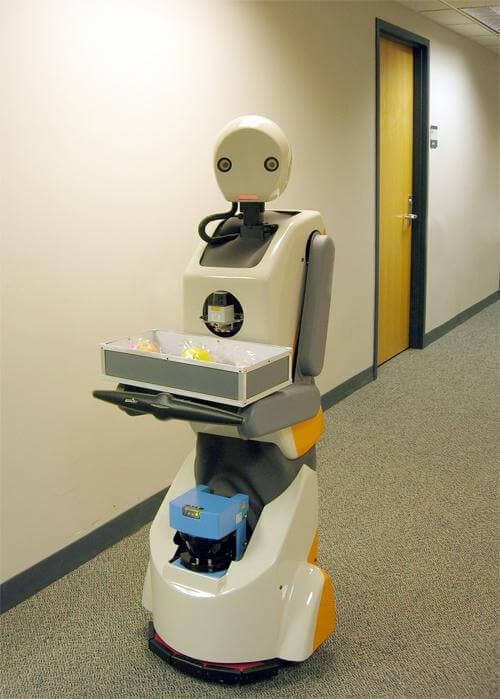New Robot Has Come To Conquer Human Race…With Snacks!

Share

Watch out Jeeves, robotic butlers could be trying to replace you. Developers at Carnegie Mellon University have created a humanoid robot that rolls around offering people snacks and souvenirs. The aptly named SnackBot is a multidisciplinary experiment that will function as a research platform for robotics, design, and behavioral sciences. SnackBot can detect humans, travel without colliding with moving objects, and even recognize people it knows. Check out the cool video from BotJunkie after the break. Snackbot was also featured in a CBS report about the economy of Pittsburgh, that video is after the break as well.
It's sort of assumed that robots could one day function as our servants. In order to work in a human environment robots have to navigate their way around, communicate, and be accepted. SnackBot aims to learn more about each of these tasks while providing a useful community service. As robotic engineers become more adept at mimicking the human body, the most critical determinant of success may not be robot capability but human-robot interaction. Projects like SnackBot could help us plan how best to incorporate robots into our daily lives. Should they be cute? How well do they need to understand human speech? What tasks will humans trust robots to perform? Answering these questions will determine what robotic engineering tries to accomplish in the years ahead.
SnackBot.org Video courtesy of BotJunkie
Maneuvering through a dynamic work space isn't simple, and SnackBot has to offer snacks while it's dodging around. In this way, the robot is similar to the PR2 from Willow Garage. Both can reason how to traverse through areas with moving objects and humans. Both can also plan a route with incomplete information. SnackBot, however, is much more focused on communicating with people.
Be Part of the Future
Sign up to receive top stories about groundbreaking technologies and visionary thinkers from SingularityHub.


As described in their paper in the Proceedings of Human Robot Interaction, the Carnegie Mellon Team is using SnackBot to understand how humans perceive and dialogue with inanimate objects. The CM design team went to great efforts to develop SnackBot holistically, considering it as a provider of a service while still worrying about the technical aspect of its build. To this end, SnackBot focuses a lot on communicating with humans. It has a LED mouth to give the impression that it is 'talking', and can interact with humans passively (it sits in a room and lets people approach on their own) or actively (it can follow maps to deliver snacks to those who request them).
The height of SnackBot was also determined through a survey where people rated their interactions with different sized bots. Small bots were too servile, and the taller bots were easier to interact with and no more intimidating for their size. Hence SnackBot is tall enough to be near chest level for most adults. In this way, SnackBot is as much a study in behavioral sciences as it is in robotics.
The results are...cute. Just like the ACE robot in Munich, the SnackBot project demonstrates that humans are quite willing to treat robots with respect and help them accomplish their tasks. It probably doesn't hurt that SnackBot is feeding the people it talks to. It's cool that Carnegie Mellon decided to approach this project from many different disciplines and with holistic considerations. As robots become larger parts of our lives, designers will have to worry as much about how the machines will be perceived as about how they can accomplish their jobs. Human-robot interaction may dictate the size, shape, and attitude of bots. I hope they all come bearing gifts.
[photo credit: SnackBot.org]
[video credits: SnackBot/BotJunkie, CBS News]
Related Articles

These Robots Are the Size of Single Cells and Cost Just a Penny Apiece

In Wild Experiment, Surgeon Uses Robot to Remove Blood Clot in Brain 4,000 Miles Away

A Squishy New Robotic ‘Eye’ Automatically Focuses Like Our Own
What we’re reading